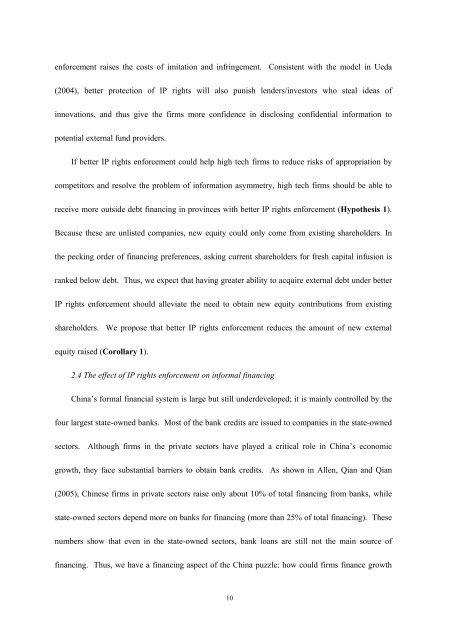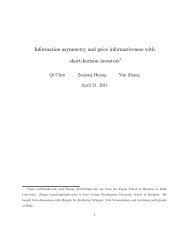Does Enforcement of Intellectual Property Rights Matter in China ...
Does Enforcement of Intellectual Property Rights Matter in China ...
Does Enforcement of Intellectual Property Rights Matter in China ...
You also want an ePaper? Increase the reach of your titles
YUMPU automatically turns print PDFs into web optimized ePapers that Google loves.
enforcement raises the costs <strong>of</strong> imitation and <strong>in</strong>fr<strong>in</strong>gement. Consistent with the model <strong>in</strong> Ueda<br />
(2004), better protection <strong>of</strong> IP rights will also punish lenders/<strong>in</strong>vestors who steal ideas <strong>of</strong><br />
<strong>in</strong>novations, and thus give the firms more confidence <strong>in</strong> disclos<strong>in</strong>g confidential <strong>in</strong>formation to<br />
potential external fund providers.<br />
If better IP rights enforcement could help high tech firms to reduce risks <strong>of</strong> appropriation by<br />
competitors and resolve the problem <strong>of</strong> <strong>in</strong>formation asymmetry, high tech firms should be able to<br />
receive more outside debt f<strong>in</strong>anc<strong>in</strong>g <strong>in</strong> prov<strong>in</strong>ces with better IP rights enforcement (Hypothesis 1).<br />
Because these are unlisted companies, new equity could only come from exist<strong>in</strong>g shareholders. In<br />
the peck<strong>in</strong>g order <strong>of</strong> f<strong>in</strong>anc<strong>in</strong>g preferences, ask<strong>in</strong>g current shareholders for fresh capital <strong>in</strong>fusion is<br />
ranked below debt. Thus, we expect that hav<strong>in</strong>g greater ability to acquire external debt under better<br />
IP rights enforcement should alleviate the need to obta<strong>in</strong> new equity contributions from exist<strong>in</strong>g<br />
shareholders. We propose that better IP rights enforcement reduces the amount <strong>of</strong> new external<br />
equity raised (Corollary 1).<br />
2.4 The effect <strong>of</strong> IP rights enforcement on <strong>in</strong>formal f<strong>in</strong>anc<strong>in</strong>g<br />
Ch<strong>in</strong>a’s formal f<strong>in</strong>ancial system is large but still underdeveloped; it is ma<strong>in</strong>ly controlled by the<br />
four largest state-owned banks. Most <strong>of</strong> the bank credits are issued to companies <strong>in</strong> the state-owned<br />
sectors. Although firms <strong>in</strong> the private sectors have played a critical role <strong>in</strong> Ch<strong>in</strong>a’s economic<br />
growth, they face substantial barriers to obta<strong>in</strong> bank credits. As shown <strong>in</strong> Allen, Qian and Qian<br />
(2005), Ch<strong>in</strong>ese firms <strong>in</strong> private sectors raise only about 10% <strong>of</strong> total f<strong>in</strong>anc<strong>in</strong>g from banks, while<br />
state-owned sectors depend more on banks for f<strong>in</strong>anc<strong>in</strong>g (more than 25% <strong>of</strong> total f<strong>in</strong>anc<strong>in</strong>g). These<br />
numbers show that even <strong>in</strong> the state-owned sectors, bank loans are still not the ma<strong>in</strong> source <strong>of</strong><br />
f<strong>in</strong>anc<strong>in</strong>g. Thus, we have a f<strong>in</strong>anc<strong>in</strong>g aspect <strong>of</strong> the Ch<strong>in</strong>a puzzle: how could firms f<strong>in</strong>ance growth<br />
10



